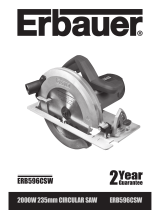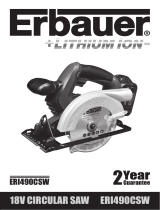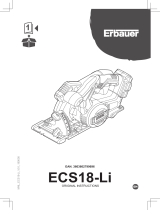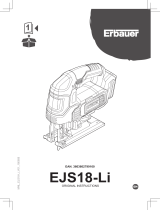Page is loading ...

EAN: 3663602628255(B&Q)
5052931644452(SFD)
ERB690CSW
ORIGINAL INSTRUCTIONS V01-180630

Guarantee
Declaration of Conformity
Product description
Assembly
Use
Care & maintenance
Safety instructions
2

3
WARNING ! Please read all safety warnings carefully and be
sure that they are fully understood before handling the tool.
x
1
1

4
Product description
Fig. 1
Fig. 2
1
2
3
33
4
5
6
7
8
9
10
11
12
13
14
16
17
15
23
18
19
20
21
22
21
24
25
30
27
26
29
28
31
32

5
A
D2D1
C
B
16
14
15
12
13
4
c
b
a
d

6
D3
E
F
D5
D4
H
G
Hex key
d1
d2
Hex screw
d1
d2
Hex screw
Hex key
1
2
6
B
A

7
I
M
L
K
29
1
24
18
Min.16mm
1
2
1
2
15
18
J

8
N
P
O
Q
9
8
10
A
7

9
R
T1S2
S
T3
T2
B
1
2
32

10
U
T4 T5
1
U3
U2
max.55mm
11
5
a
11
5
21
21
max.55mm
max.55mm

11
V
W W43
W2
W1
29
25
Outer flange
Saw blade
Inner flange
Screw
Output spindle
19

WARNING ! Read all safety warnings, instructions,
illustrations and specifications provided with this
power tool. Failure to follow all instructions listed
below may result in electric shock, fire and/or serious
injury. Save all warnings and instructions for future
reference. The term “power tool” in the warnings
refers to your mains-operated (corded) power tool or
battery-operated (cordless) power tool.
Safety instructions
WORK AREA SAFETY
a) Keep work area clean and well lit. Cluttered or dark areas invite accidents.
b) Do not operate power tools in explosive atmospheres, such as in the
presence of flammable liquids, gases or dust. Power tools create sparks
which may ignite the dust or fumes.
c) Keep children and bystanders away while operating a power tool.
Distractions can cause you to lose control.
ELECTRICAL SAFETY
a) Power tool plugs must match the outlet. Never modify the plug in any way.
Do not use any adapter plugs with earthed (grounded) power tools. Unmodified
plugs and matching outlets will reduce risk of electric shock.
b) Avoid body contact with earthed or grounded surfaces, such as
pipes, radiators, ranges and refrigerators. There is an increased risk of
electric shock if your body is earthed or grounded.
c) Do not expose power tools to rain or wet conditions. Water entering a
power tool will increase the risk of electric shock.
d) Do not abuse the cord. Never use the cord for carrying, pulling or
unplugging the power tool. Keep cord away from heat, oil, sharp edges or
moving parts. Damaged or entangled cords increase the risk of electric shock.
e) When operating a power tool outdoors, use an extension cord suitable
for outdoor use. Use of a cord suitable for outdoor use reduces the risk of
electric shock.
f) If operating a power tool in a damp location is unavoidable, use a
residual current device (RCD) protected supply. Use of an RCD reduces
the risk of electric shock.
GENERAL POWER TOOL SAFETY WARNINGS
12

13
e) Do not overreach. Keep proper footing and balance at all times. This
a) Stay alert,watch what you are doing and use common sense when
operating a power tool. Do not use a power tool while you are tired
or under the influence of drugs, alcohol or medication. A moment of
inattention while operating power tools may result in serious personalinjury.
b) Use personal protective equipment. Always wear eye protection.
Protective equipment such as dust mask,non-skids afety shoes, hard hat, or
hearing protection used for appropriate conditions will reduce personal injuries.
c) Prevent unintentional starting. Ensure the switch is in the off-
position before connecting to power source and/or battery pack,
p
icking up or carrying the tool. Carrying power tools with your finger on the
switch or energising power tools that have the switch on invites accidents.
d) Remove any adjusting key or wrench before turning the power
tool on. A wrench or a key left attached to a rotating part of the power tool may
result in personal injury.
enables better control of the power tool in unexpected situations.
f) Dress properly. Do not wear loose clothing or jewellery. Keep your
hair, clothing and gloves away from moving parts. Loose clothes, jewellery
or long hair can be caught in moving parts.
g) If devices are provided for the connection of dust extraction and
collection facilities, ensure these are connected and properly used. Use of
dust collection can reduce dust-related hazards.
h) Do not let familiarity gained from frequent use of tools allow you to
become complacent and ignore tool safety principles. A careless action can
cause severe injury within a fraction of a second.
POWER TOOL USE AND CARE
PERSONAL SAFETY
a) Do not force the power tool. Use the correct power tool for your
application. The correct power tool will do the job better and safer at the rate for
which it was designed.
b) Do not use the power tool if the switch does not turn it on and off. Any
power tool that cannot be controlled with the switch is dangerous and must be
repaired.
c) Disconnect the plug from the power source and/or the battery pack from
the power tool before making any adjustments, changing accessories, or
storing power tools. Such preventive safety measures reduce the risk of starting
the power tool accidentally.
d) Store idle power tools out of the reach of children and do not allow
persons unfamiliar with the power tool or these instructions to operate the
power tool.Power tools are dangerous in the hands of untrained users.

14
CUTTING PROCEDURES
DANGER ! Keep hands away from cutting area and the blade. Keep
your second hand on auxiliary handle, or motor housing. If both hands
are holding the saw, they cannot be cut by the blade.
a) Do not reach underneath the workpiece. The guard cannot protect you
from the blade below the workpiece.
b) Adjust the cutting depth to the thickness of the workpiece. Less than a
full tooth of the blade teeth should be visible below the workpiece.
c) Never hold the workpiece in your hands or across your leg while cutting.
Secure the workpiece to a stable platform. It is important to support the work
properly to minimise body exposure, blade binding, or loss of control.
d) Hold the power tool by insulated gripping surfaces, when performing an
operation where the cutting tool may contact hidden wiring or its own cord.
Contact with a "live" wire will also make exposed metal parts of the power tool
"live" and could give the operator an electric shock.
SAFETY INSTRUCTIONS FOR YOUR SAW
SERVICE
e) Maintain power tools. Check for misalignment or binding of moving
parts,breakage of parts and any other condition that may affect the power
tools operation. If damaged, have the power tool repaired before use. Many
accidents are caused by poorly maintained power tools.
f) Keep cutting tools sharp and clean. Properly maintained cutting tools with
sharp cutting edges are less likely to bind and are easier to control.
g)
a) Have your power tool serviced by a qualified repair person using only
identical replacement parts. This will ensure that the safety of the power tool
is maintained.
Use the power tool, accessories and tool bits etc. in accordance with
these instructions, taking into account the working conditions and the work
to be performed. Use of the power tool for operations different from those
intended could result in a hazardous situation.
h) Keep handles and grasping surfaces dry, clean and free from oil and
grease. Slippery handles and grasping surfaces do not allow for safe handling
and control of the tool in unexpected situations.

15
e) When ripping, always use a rip fence or straight edge guide. This improves
the accuracy of cut and reduces the chance of blade binding.
f) Always use blades with correct size and shape (diamond versus round)
of arbour holes. Blades that do not match the mounting hardware of the saw
will run off-centre, causing loss of control.
g) Never use damaged or incorrect blade washers or bolt. The blade washers
and bolt were specially designed for your saw, for optimum performance and
safety of operation.
a) Maintain a firm grip with both hands on the saw and position your arms to
resist kickback forces. Position your body to either side of the blade but not
in line with the blade. Kickback could cause the saw to jump backwards, however,
if precautions are taken, kickback forces can be controlled by the operator.
KICKBACK CAUSES AND RELATED WARNINGS
Kickback is a sudden reaction to a pinched, jammed or misaligned saw blade,
causing an uncontrolled saw to lift up and out of the workpiece toward the operator.
When the blade is pinched or jammed tightly by the kerf closing down, the blade
stalls and the motor reaction drives the unit rapidly back toward the operator. If the
blade becomes twisted or misaligned in the cut, the teeth at the back edge of the
blade can dig into the top surface of the wood causing the blade to climb out of the
kerf and jump back toward the operator.
Kickback is the result of saw misuse and/or incorrect operating procedures or
conditions and can be avoided by taking proper precautions as given below.
work or pull the saw backward while the blade is in motion or kickback may occur.
Investigate and take corrective action to eliminate the cause of blade binding.
c) When restarting a saw in the workpiece, centre the saw blade in the kerf
so that the saw teeth are not engaged into the material. If a saw blade binds,
it may walk up or kickback from the workpiece as the saw is restarted.
d) Support large panels to minimise the risk of blade pinching and kickback.
Large panels tend to sag under their own weight. Supports must be placed
under the panel on both sides, near the line of cut and near the edge of the panel.
b) When the blade is binding, or when interrupting a cut for any reason,
release the trigger and hold the saw motionless in the workpiece until the
blade comes to a complete stop. Never attempt to remove the saw from the
e) Do not use dull or damaged blades. Unsharpened or improperly set blades
produce narrow kerf causing excessive friction, blade binding and kickback.

16
GUARD FUNCTION
a) Check the guard for proper closing before each use. Do not operate the
saw if the guard does not move freely and enclose the blade instantly. Never
clamp or tie the guard so that the blade is exposed. If the saw is accidentally
dropped, the guard may be bent. Check to make sure that the guard moves freely
and does not touch the blade or any other part, in all angles and depths of cut.
b) Check the operation and condition of the guard return spring. If the guard
and the spring are not operating properly, they must be serviced before use.
The guard may operate sluggishly due to damaged parts, gummy deposits, or a
build-up of debris.
c) Assure that the base plate of the saw will not shift while performing a
“plunge cut”.Blade shifting sideways will cause binding and likely kick back.
d) Always observe that the guard is covering the blade before placing the
saw down on bench or floor. An unprotected, coasting blade will cause the saw
to walk backwards, cutting whatever is in its path. Be aware of the time it takes for
the blade to stop after the switch is released.
The following information applies to professional users only but is good practice
for all users:
f) Blade depth and bevel adjusting locking levers must be tight and secure
before making the cut. If blade adjustment shifts while cutting, it may cause
binding and kickback.
g) Use extra caution when sawing into existing walls or other blind areas.
The protruding blade may cut objects that can cause kickback.
ADDITIONAL SAFETY WARNING FOR CONSTRUCTION DUST
The updated Control of Substances Hazardous to Health Regulations 1st
October 2012 now also targets to reduce the risks associated with silica, wood
and gypsum dusts.
Construction workers are one of the at-risk groups within this because of the
dust that they breathe: silica dust is not just a nuisance; it is a real risk to your
lungs!
Silica is a natural mineral present in large amounts in things like sand, sandstone
and granite. It is also commonly found in many construction materials such as
concrete and mortar. The silica is broken into very fine dust (also known as
Respirable Crystalline Silica or RCS) during many common tasks such as
cutting, drilling and grinding Breathing in very fine particles of crystalline silica
can lead to the development of:

17
Lung cancer Silicosis Chronic Obstructive Pulmonary Disorder (Chronic
obstructive pulmonary disease (COPD) And breathing in fine particles of wood
dust can lead to the development of Asthma The risk of lung disease is linked to
people who regularly breathe construction dust over a period of time, not on the
odd occasion.
To protect the lung, the COSHH Regulations sets a limit on the amount of these
dusts that you can breathe (called a Workplace Exposure Limit or WEL) when
averaged over a normal working day. These limits are not a large amount of dust:
when compared to a penny it is tiny – like a small pinch of salt:
This limit is the legal maximum; the most you can breathe after the right controls
have been used.
How to reduce the amount of dust?
1. Reduce the amount of cutting by using the best sizes of building products.
2. Use a less powerful tool e.g. a block cutter instead of angle grinder.
3. Using a different method of work altogether – e.g. using a nail gun to
direct fasten cable trays instead of drilling holes first.
Please always work with approved safety equipment, such as those dust
masks that specially designed to filter out microscopic particles and use the
dust extraction facility at all time.
For more information please see the HSE website:
http://www.hse.gov.uk/construction or http://www.hse.gov.uk/pubns/cis69.pdf
WARNING ! Some dust particles created by power sanding, sawing,
grinding, drill and other construction jobs contain chemicals known to
cause cancer, birth defects or other reproductive harm. Some
examples of these chemicals are:
- Lead from lead-based paints.
- Crystalline silica from bricks and cement and other masonry
products.
- Arsenic and chromium from chemically treated timber.
- Your risk from these exposures varies, depending upon how often
you do this type of work. To reduce your exposure to these
chemicals:
- Work in a well-ventilated area.
- Work with approved safety equipment, such as those dust masks
that are specially designed to filter microscopic particles.

18
VIBRATION
The European Physical Agents (Vibration) Directive has been brought in to
help reduce hand arm vibration syndrome injuries to power tool users. The
directive requires power tool manufacturers and suppliers to provide indicative
vibration test results to enable users to make informed decisions as to the period
of time a power tool can be used safely on a daily basis and the choice of tool.
SEE TECHNICAL SPECIFICATIONS IN THE INSTRUCTION MANUAL FOR THE
IBRATION LEVELS OF YOUR TOOL.
The declared vibration emission value should be used as a minimum level
and should be used with the current guidance on vibration.
Calculating the actual period of the actual period off use can be difficult and
the HSE website has further information.
WARNING ! The vibration emission value during actual use of the
power tool can differ from the declared value depending on the ways
in which the tool is used dependant on the following examples and
other variations on how the tool is used:
- How the tool is used and the materials being cut or drilled.
- The tool being in good condition and well maintained.
- The use the correct accessory for the tool and ensuring it is sharp
and in good condition.
- The tightness of the grip on the handles.
- And the tool is being used as intended by its design and these
instructions.
The declared vibration emission been measured in accordance with a standardised
test stated above and may be used to compare one tool with another tool.
The declared vibration emission value may also be used in preliminary assessment
of exposure.
While working with this power tool, hand/arm vibrations occur. Adopt the correct
working practices in order to reduce the exposure to vibration. This tool may
cause hand-arm vibration syndrome if its use is not adequately managed.

19
WARNING ! Identify safety measures to protect the
operator that are based on an estimation of exposure in
the actual conditions of use (taking account of all parts of
the operating cycle such as the times when the tool is
switched off and when it is running idle in addition to the
trigger time).
Note : The use of other tools will reduce the users’ total
working period on this tool.
Helping to minimise your vibration exposure risk. ALWAYS use sharp chisels,
drills and blades.
Maintain this tool in accordance with these instructions and keep well lubricated
(where appropriate).
Avoid using tools in temperatures of 10ºc or less. Plan your work schedule to
spread any high vibration tool use across a number of days.
HEALTH SURVEILLANCE
All employees should be part of an employer’s health surveillance scheme to
help identity any vibration related diseases at an early stage, prevent disease
progression and help employees stay in work.

20
TECHNICAL SPECIFICATIONS
1. Plunge lock button
2. ON/OFF switch
3. Main handle
4. Rear bevel lock knob
5. Rear parallel guide
fixing screw
6. Base plate
7. Rear fine adjustment
knob
8. Anti-kickback knob
9. Track lock
10. Front fine
adjustment knob
11. Front parallel guide
fixing screw
12. Front bevel lock
knob
13. Bevel scale
14. Depth adjustment
knob
15. Track compensation
16. Depth scale
17. Auxiliary handle
18. Mode selector
19. Carbon brush cap
(2x)
20. Slot for track
21. Slot for Parallel Guide
22. Cutting width
indicators
23. Saw blade
24. Dust extraction
outlet
25. Shaft lock
26. 5mm hex key
27. 700mm track x2
28. 3mm hex key
29. Connection adapter
30. Parallel Guide
31. Dust collection bag
32. W
33. Speed regulator
ork clamps x2
Rated input: 220-240V~50Hz
Rated power: 1400W
No load speed: 2000-5000/min
Mitre setting: 0°- 48°
Saw blade dimensions: Ø185x2.2x20mm
Max. cutting depth with track: 62mm at 90°
Max. cutting depth without track: 67mm at 90°
Max. cutting depth with track: 44mm at 45°
Max. cutting depth without track: 47mm at 45°
Protecting rating: IPX0
Protecting class: II
Net weight: 5.4 kg
NOISE DATA & VIBRATION LEVEL
• Noise pressure level (L
): 97 dB(A) (K : 3 dB )
• Sound power level (L ): 108 dB(A) (K : 3dB)
• Hand-Arm-Vibration hand grip: 4.8m/s
2
(K= 1.5m/s )
2
Product description
01
PA PA
WA WA
/










